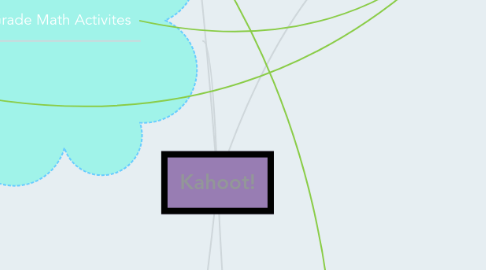
1. Teacher roles
1.1. Instructor
1.1.1. What is Kahoot?
1.1.2. How do we use Kahoot?
1.1.3. Why do we use Kahoot?
1.2. Monitor
1.2.1. While game is being played
1.3. Leader
1.3.1. Head of the class discussion
1.3.2. Gives cues on when it's time to transition
1.4. Helper
1.4.1. Tecnological difficulties
1.4.2. Give helpful hints during game play
1.4.3. Resolve any issues that may arise
1.5. Examiner
1.5.1. Asses student's achievement
1.5.2. Notice developmental delay
1.5.3. Did this activity help my students?
1.5.4. Did I do my best to make this activity beneficial for all?
1.6. Evaluator
1.6.1. Notice difference in student achievement
1.6.2. Did it efficiently teach students?
1.6.3. Did it provide enough learning materials for my students?
1.6.4. What could be done differently to make this activity even better in the future?
1.7. Planner
1.7.1. Create enough questions for a whole class period
1.7.2. Allot enough time for supplemental questions
1.7.3. Develop game being played
1.7.4. Create transitioning period
1.7.5. Revise lesson to make sure everything will be covered
2. Learning Assesment
2.1. Problem Based Learning
2.1.1. Pinpoints students strengths and weaknesses when knowing the content
2.1.2. Students identify what they already know and what they need to know
2.1.3. Helps determine a student's knowledge and skills
2.2. Communal Approach Towards Learning
2.2.1. Allows students to bounce ideas off eachother
2.2.2. Working in groups helps foster learning through teaching others
2.3. Provides quick feedback for teachers
2.3.1. Teachers can see what their students need more assistance with
2.4. Challenges the students ability to understand the content
2.4.1. Students answer questions in a time frame challenging their knowledge of the content
2.4.2. Helps students determine their knowledge and skills
3. 1st Grade Math Activites
3.1. Learning Concepts
3.1.1. Matching
3.2. Problem Solving
3.2.1. Addition and Subtraction problems
3.2.2. Partner races
3.3. Counting Skills
3.3.1. Counting backwards
3.3.2. Learning number order
4. Learning Activities
4.1. Quizzes
4.1.1. Students create own questions on topics of addition/subtraction, currency and measurements, and counting numbers(main topics in first grade math)
4.1.1.1. Provides a better understanding of the material for the students
4.1.1.2. Helps support active learning in the classroom; gets students involved in helping create the lesson
4.1.2. Teacher chooses to create own quiz or choose from Kahoot! public quizzes-played through ipads
4.1.2.1. Teacher is able to see the progress of students through the quiz, showing on her screen top 5 students on scoreboard
4.1.2.2. Can see what topics need to be further discussed and what is easily understood
4.1.2.3. Results provide percentage of students who chose the correct answer
4.2. Discussions
4.2.1. Teachers use a tool for quick questioning throughout their daily discussions
4.2.1.1. Present information, then pull up single question to see if students understood the information
4.2.1.2. Breaks up lectures into sections providing breaks for students to be able to take in what was just dicussed
4.2.2. Students can create one question going along with the lecture in class and share with their peers
4.2.2.1. Also helps students become involved in creating lesson
4.3. Surveys
4.3.1. Teacher creates surveys to identify what students already know and still need to learn
4.3.1.1. No right or wrong answers, just a bar graph showing results
4.3.2. Students can create own surveys with the information they know; can be shared with peers
5. Learning Goals
5.1. Social
5.1.1. Create an environment that allows students to work on social learning.
5.1.1.1. Through the interaction with the class while playing the games as a group, the students will learn how to learn in a social environment.
5.2. Comprehension
5.2.1. Be able to teach and then check understanding of the whole class.
5.2.1.1. The students will show comprehension by correctly answering the questions on the game and the teacher will be gage how many of the students understood the lesson that was taught.
5.3. Application
5.3.1. Use learning from classroom to allow students to create their own set of questions.
5.3.1.1. Applying the knowledge learned in the classroom, students will make their own game. The students will be able to allow others to play their game as well as play the games their peers create.
5.4. Research
5.4.1. Research topics being learned in the classroom.
5.4.1.1. Present research through the easy to use technology. You are able to include pictures, videos, and links to easily explain the information that has been researched.
